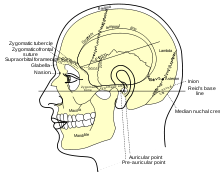Glabella
The glabella ( Latin glabellus , diminutive of glaber , 'smooth', 'hairless') is the skin region between the eyebrows and the bony elevation of the frontal bone above the bridge of the nose below this point .
This elevation of the frontal bone between the eyebrow arches is an important distinguishing feature between men and women and is therefore used - always in connection with other bone characteristics - in archeology and forensic osteology to determine the sex of skeletal finds. In women, the elevation is usually not highlighted at this point, the transition to the bridge of the nose is fluid, in men, however, it is prominent and set off against the bridge of the nose. In anthropology , too , the glabella is an important morphological measuring point for the length of the head and the size of the brain skull .
Orbicularis oculi reflex
Knocking on the glabella when the eyes are closed usually results in reflexive squinting of both eyes, the eyelid closing reflex (orbicularis oculi reflex). If this reflex is missing, this indicates incomplete healing of a facial paralysis .
Trilobite glabella
In the trilobites , extinct marine arthropods from the Paleozoic , the glabella ("bald head") is the extension of the spindle (middle lobe ) on the cephalon (head shield). The glabella is always raised and bordered by furrows all around. Their shape and the formation of their surface (e.g. trimmings with knots) is species-specific.
Web links
- The bony skull - a picture dictionary. Frontal bone: glabella. Alphabetical picture dictionary, University of Mainz
- Trilobite morphology. (September 30, 2009 memento in the Internet Archive ) Glossary of the Division of Environmental and Life Sciences at Macquarie University in Sydney
Individual evidence
- ↑ Cordula Mauerer: Morphological and molecular biological sex determination of individuals with bone fractures from a skeletal series of the 15th – 18th centuries. Century from southern Germany (Rain am Lech) . 2006, p. 19th ff . ( Online [PDF; 1.5 MB ] Dissertation at the Pathological Institute of the Ludwig Maximilians University in Munich ).
- ↑ Heinz-Walter Delank, Walter Gehlen: Neurology . 11th edition. Georg Thieme, Stuttgart 2006, ISBN 3-13-129771-9 , p. 19 ( limited preview in Google Book search).
- ^ Ulrich Lehmann: Paleontological Dictionary . 4th edition. Enke, Stuttgart 1996.

